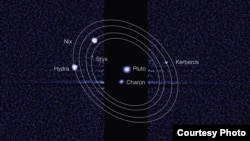Pluto’s recently discovered moons now have names.
The International Astronomical Union (IAU) announced that Pluto’s fourth and fifth moons, discovered in 2011 and 2012, will be named Kerberos and Styx. The moons were formerly known as P4 and P5.
Kerberos and Styx were first observed by the NASA/ESA Hubble Space Telescope Wide Field Camera 3. Kerberos’ orbit is between Nix and Hydra, two bigger moons discovered by Hubble in 2005, and Styx is between Charon, the innermost and biggest moon, and Nix.
According to the IAU, Kerberos has an estimated diameter of 13 to 34 kilometers, while Styx is 10 to 25 kilometers across.
The names were voted for by the public and had to be consistent with the names of the dwarf planet’s other moons by making reference to classical mythology’s underworld.
To avoid confusion with the asteroid 1865 Cerberus, the Greek spelling of the word was used. According to mythology, Cerberus — or Kerberos in Greek — was a many-headed dog that guarded the entrance to the underworld. Styx is the name of the goddess who ruled over the underworld river.
The International Astronomical Union (IAU) announced that Pluto’s fourth and fifth moons, discovered in 2011 and 2012, will be named Kerberos and Styx. The moons were formerly known as P4 and P5.
Kerberos and Styx were first observed by the NASA/ESA Hubble Space Telescope Wide Field Camera 3. Kerberos’ orbit is between Nix and Hydra, two bigger moons discovered by Hubble in 2005, and Styx is between Charon, the innermost and biggest moon, and Nix.
According to the IAU, Kerberos has an estimated diameter of 13 to 34 kilometers, while Styx is 10 to 25 kilometers across.
The names were voted for by the public and had to be consistent with the names of the dwarf planet’s other moons by making reference to classical mythology’s underworld.
To avoid confusion with the asteroid 1865 Cerberus, the Greek spelling of the word was used. According to mythology, Cerberus — or Kerberos in Greek — was a many-headed dog that guarded the entrance to the underworld. Styx is the name of the goddess who ruled over the underworld river.








